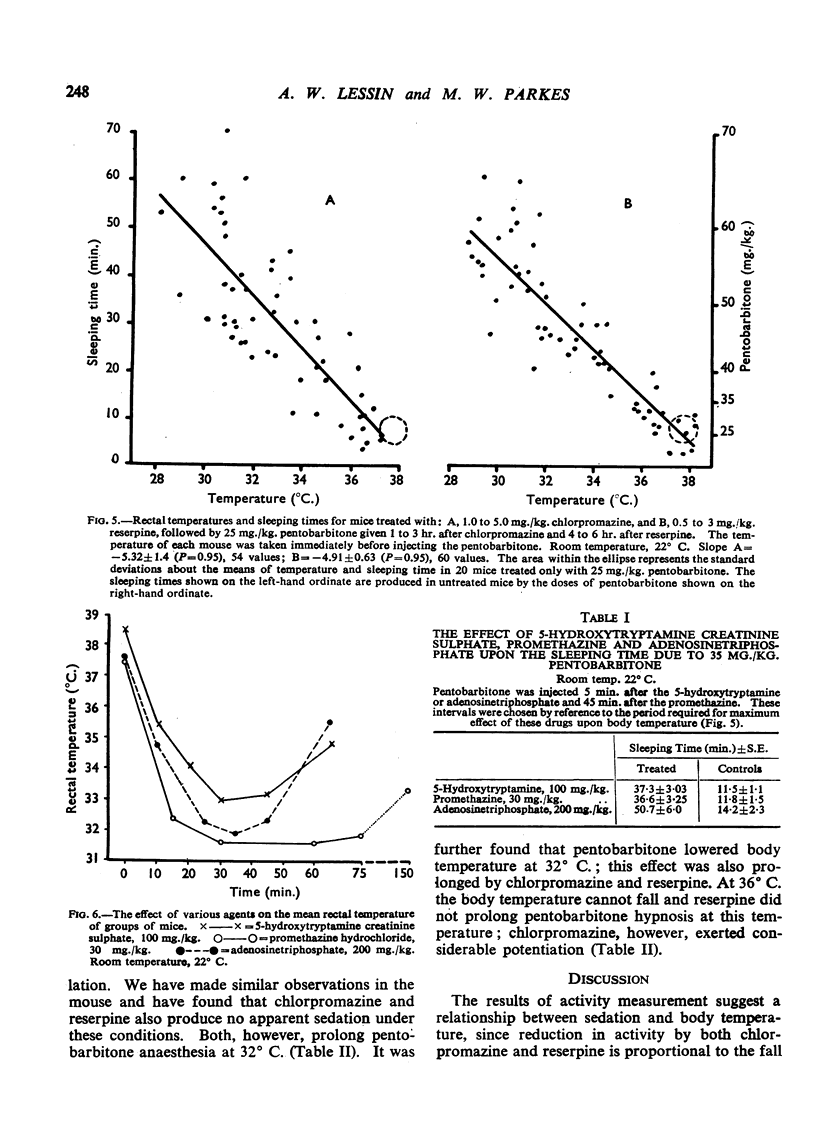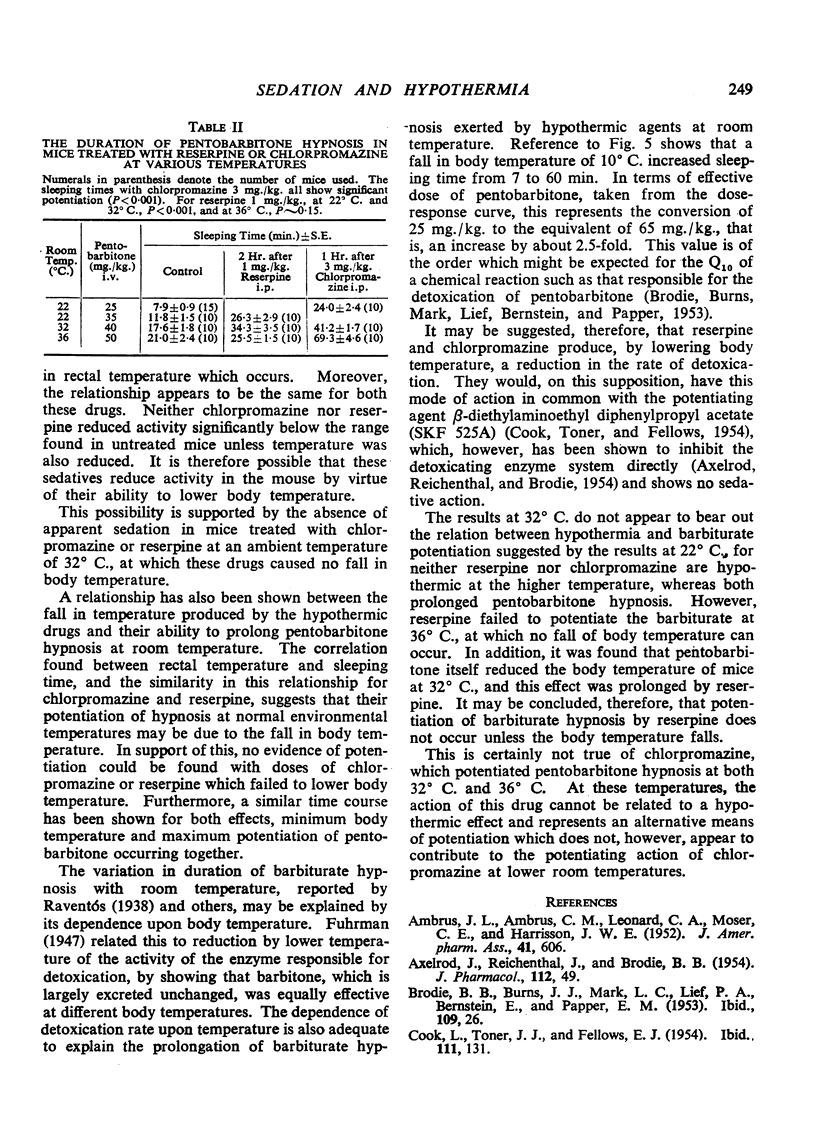Abstract
Chlorpromazine and reserpine reduce locomotor activity and prolong pentobarbitone hypnosis in mice. Both these effects are shown to be proportional to the fall in body temperature produced by these drugs. Other agents are shown to reduce body temperature and potentiate pentobarbitone. At ambient temperatures of 32° C. neither chlorpromazine nor reserpine is hypothermic or sedative. It is concluded that sedative effects in the mouse at ordinary room temperatures are related to the hypothermic properties of these drugs. At 36° C., while reserpine fails to potentiate pentobarbitone, chlorpromazine still does so.
Full text
PDF





Selected References
These references are in PubMed. This may not be the complete list of references from this article.
- AMBRUS J. L., AMBRUS C. M., LEONARD C. A., MOSER C. E., HARRISSON J. W. E. Synergism between histamine, antihistamines, and hypnotic drugs. J Am Pharm Assoc Am Pharm Assoc. 1952 Nov;41(11):606–608. doi: 10.1002/jps.3030411115. [DOI] [PubMed] [Google Scholar]
- AXELROD J., REICHENTHAL J., BRODIE B. B. Mechanism of the potentiating action of beta-diethylaminoethyl diphenylpropylacetate. J Pharmacol Exp Ther. 1954 Sep;112(1):49–54. [PubMed] [Google Scholar]
- BRODIE B. B., BURNS J. J., MARK L. C., LIEF P. A., BERNSTEIN E., PAPPER E. M. The fate of pentobarbital in man and dog and a method for its estimation in biological material. J Pharmacol Exp Ther. 1953 Sep;109(1):26–34. [PubMed] [Google Scholar]
- COOK L., TONER J. J., FELLOWS E. J. The effect of beta-diethylaminoethyl-diphenylpropylacetate hydrochloride (SKF No. 525-A) on hexobarbital. J Pharmacol Exp Ther. 1954 Jun;111(2):131–141. [PubMed] [Google Scholar]
- COURVOISIER S., FOURNEL J., DUCROT R., KOLSKY M., KOETSCHET P. Propriétés pharmacodynamiques du chlorhydrate de chloro-3-(diméthylamino-3'-propyl)-10-phénothiazine (4,560 R.P.); étude expérimentale d'un nouveau corps utilisé dans l'anesthésie potentialisée et dans l'hibernation artificielle. Arch Int Pharmacodyn Ther. 1953 Jan;92(3-4):305–361. [PubMed] [Google Scholar]
- DEWS P. B. The measurement of the influence of drugs on voluntary activity in mice. Br J Pharmacol Chemother. 1953 Mar;8(1):46–48. doi: 10.1111/j.1476-5381.1953.tb00749.x. [DOI] [PMC free article] [PubMed] [Google Scholar]
- Fuhrman F. A. The Effect of Body Temperature on the Duration of Barbiturate Anesthesia in Mice. Science. 1947 Apr 11;105(2728):387–388. doi: 10.1126/science.105.2728.387. [DOI] [PubMed] [Google Scholar]
- GRIEVE J. Sterilisable thermometer for measuring intra-abdominal temperature. Lancet. 1951 Sep 8;2(6680):431–432. doi: 10.1016/s0140-6736(51)91695-9. [DOI] [PubMed] [Google Scholar]
- KOPERA J., ARMITAGE A. K. Comparison of some pharmacological properties of chlorpromazine, promethazine, and pethidine. Br J Pharmacol Chemother. 1954 Dec;9(4):392–401. doi: 10.1111/j.1476-5381.1954.tb00851.x. [DOI] [PMC free article] [PubMed] [Google Scholar]
- MAIER A., FORSTER E., SCHAFF G., KAYSER C. Effet de la chlorpromazine sur la durée de survie du rat blanc séjournant à basse température (+5 degrees C) ou à la neutralité thermique (+31 degrees C). C R Seances Soc Biol Fil. 1955 Mar;149(5-6):568–570. [PubMed] [Google Scholar]
- PACKMAN E. W., ROSSI G. V., HARRISSON J. W. E. The effect of histamine and antihistamines on body temperature. J Pharm Pharmacol. 1953 May;5(5):301–310. doi: 10.1111/j.2042-7158.1953.tb13990.x. [DOI] [PubMed] [Google Scholar]
- PLUMMER A. J., EARL A., SCHNEIDER J. A., TRAPOLD J., BARRETT W. Pharmacology of Rauwolfia alkaloids, including reserpine. Ann N Y Acad Sci. 1954 Apr 30;59(1):8–21. doi: 10.1111/j.1749-6632.1954.tb45914.x. [DOI] [PubMed] [Google Scholar]
- SHORE P. A., SILVER S. L., BRODIE B. B. Interaction of serotonin and lysergic acid diethylamide (LSD) in the central nervous system. Experientia. 1955 Jul 15;11(7):272–273. doi: 10.1007/BF02161252. [DOI] [PubMed] [Google Scholar]


